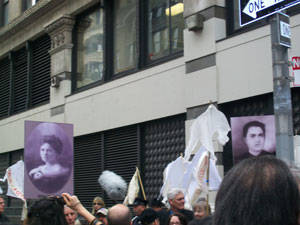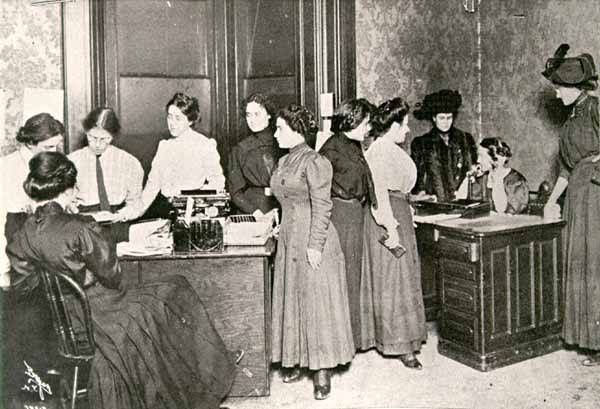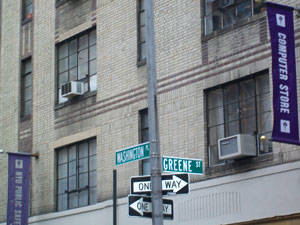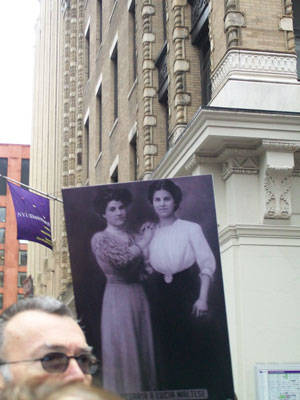The Triangle Shirtwaist Factory Fire Between Past and Present
In most cases, nowadays, when we go to our workplace one of the first things we notice is a giant sign pointing to the closest stairwell or an emergency exit; our boss might even hold a meeting for newcomers with precise and concise instructions on what to do in case of a fire; a few inches away from the sign is an alarm that is directly connected to a fire-fighters station or even more advanced technological devices to assure safety to all the workers. Norms and regulations, policies for equal opportunities and an attention to allow everyone to access or leave the building safely - at least in a city like New York in 2010 - are luckily part of our everyday experience but it hasn't always been that way.
Although sometimes there is very little you can do in case of a fire or a natural catastrophe, unions and governments in the United States have fought to guarantee more and more rights to workers, reaching some important goals over the past century: those milestones that you study in school, that affect the rights of disadvantaged minorities and change politics forever. March 25 is one of them, a National Historic Landmark, unfortunately a tragic one.
If you are a kid and go to a public school in New York City you will probably know this date by heart because every year there will be a field-trip with your classmates to the corner of Washington Place and Greene Street; under the rain or the sun, or fighting against the wind, you would proudly put on a red fire-fighter hat holding your teacher's hand or curiously looking at the much older NYU students crowding around campus, walking by. You might not fully understand what a union is, but even in kinder-garden you will realize the dangers of fire and the importance of respect and basic rights as a human being.
On March 25 1911, 99 years ago, the lives of workers and immigrants who arrived in New York were often miserable. Very few women worked and those who did, did so in very poor conditions and worked under terms that were barely legal. During the 20th century Italians and Jews were among the immigrants that tried to start a new life in a new world no matter how hard it was to do so and on that bright Spring day of 1911 the women who were working at the Triangle Shirtwaist Factory (mostly Italians and Jews) were the victims of one of the largest industrial disasters in New York and the worst workplace disaster before 9/11. 146 garment workers died while the building was destroyed by fire or jumping out of windows.
As the flames reached up to the 9th and 10th floors of the factory nobody was able to escape. After a few years of strikes and protests by the unions (where women were beaten by policemen to obtain basic rights), the relationship between the owners of the factory, Max Blanck and Isaac Harris, and the garment workers were tense and some of the details of that day, that triggered the resentment of many workers later on, were unclear as far as who could be blamed. The doors of the factory were locked because it was a Saturday (normally not a work day) and it is said that the owners felt this would “keep the women busy at their machines”, preventing them from taking cigarette breaks.
When the firefighters came they couldn’t reach the higher floors because their ladder was too short and that is why today there is a symbolic rising of the ladder along with many other commemorations where the new modern ladder rises up above the Asch Building (now Brown Building of Science, NYU) where the factory was.
The aftermath of this tragic accident was filled with protests and huge changes in terms of workplace’s legislation. The International Ladies’ Garment Workers’ Union fought for safer conditions, and stricter regulations in case of fire were applied all over the city and the country.
In 2010 public school students, union workers and demonstrators, women, descendants of the few survivors or relatives of the victims, gathered around the Asch Building to commemorate the event. Due to the high number of students the atmosphere was almost didactic with songs and speeches encouraging not only remembrance, learning and teaching important lessons, but also explaining clearly why this is a New York City Landmark and why it’s crucial that the young generations be fully aware of how to make the world a better and safer place in the name of solidarity, dignity and respect. The leader of the Teacher’s Union in New York encouraged the children to “raise your voice when something is wrong”. The emphasis on young generations is not just rhetorical in this case since the women who died were all between the ages of 13 and 23, which nowadays would still be considered “kids”.
The musical band Fiasco and the NYC Labor Chorus sang various Union songs, folk and popular songs that emphasized the camaraderie of the workers, the strength of those who fought together for a cause and were linked to the time or the origins of the victims. One song stood above all, a song that is often linked to the Italian Resistance but that was created and sung before by the garment workers and the field workers in Italy, called “Bella Ciao”. The song is often sung in political demonstrations in Italy to evoke communist ideals and refresh the memory of what the partisans did, dying for the freedom of the country (e questo è il fiore del partigiano morto per la libertà; "this flower stands here for a partisan who died for freedom”) . Here it didn’t have a revolutionary connotation, but more of a sense of nostalgia and sadness for those who gave their life in vain.
Most of the people standing at the corner of Green and Washington Place were holding in their hands white pieces of cloth or signs with attached a white shirt-waist with the names of those women who died written on it. All the women were singing together maybe thinking of their ancestors and of the fact that a few weeks before, on March 8, the whole world celebrates yearly the International Women’s Day. It’s celebrated also as a recurrence created in relation to this tragic fire.
Each one of the speakers shared their point of view with the crowd and the relatives retold the sad stories of that day. Bruce Raynor, President of Union Workers United reiterated the importance of dignity, respect and protection on any job. The firefighters underlined the importance of hard work and sacrifice.
A memorable and significant account came from the NYC Comptroller John C. Liu an immigrant himself who arrived in the United States when he was five year old from Taiwan, son of a banker and of a garment worker. Because of his mother, John C. Liu said he could relate and sympathize with the victims since he had to work with her in a sweatshop when he was very young.
The immigrants of today are no longer Italians or Irish but Chinese or Mexicans, for example, and unfortunately even in our modern society most of them are not protected enough on the workplace. Even worse are the conditions of certain factories in other countries, such as Bangladesh.
Paradoxically, as some NYU students involved in the democratic groups on campus pointed out during the event, due to the economic crisis a lot of fundings and supplies were cut to the fire department this year.
Almost a 100 years after the Triangle Factory Fire the picture is far from being perfect.
The hope is that the white shirtwaists lifted up in the sky, the myriads of events all across the city programed every year to honor this national landmark, the stories of those who burnt in less than fifteen minutes will always stir people’s conscience and remind them that productivity and making more money is never more important than safety.










































i-Italy
Facebook
Google+
This work may not be reproduced, in whole or in part, without prior written permission.
Questo lavoro non può essere riprodotto, in tutto o in parte, senza permesso scritto.